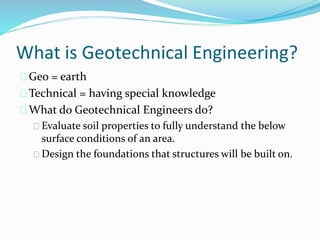An Unbiased View of Geotheta
An Unbiased View of Geotheta
Blog Article
8 Easy Facts About Geotheta Described
Table of ContentsThe 5-Second Trick For GeothetaRumored Buzz on GeothetaNot known Facts About GeothetaThe Definitive Guide for GeothetaThe Main Principles Of Geotheta

They conduct website examinations, accumulate samples, execute lab tests, and analyze information to assess the viability of the ground for building jobs - Consulting Engineers. Based on their findings, geotechnical designers provide suggestions for structure design, slope security, maintaining structures, and mitigation of geotechnical dangers. They collaborate with various other specialists, such as designers, structural engineers, and building groups, to ensure that geotechnical factors to consider are incorporated right into the general job style and execution
By evaluating the behavior and residential or commercial properties of dirt and rock, they can determine possible geotechnical threats such as landslides, dirt negotiation, or incline instability. Their expertise assists prevent failings or accidents that could jeopardize lives and residential property. Below are some thorough obligations and duties of a geotechnical designer: Site Examination: Geotechnical engineers conduct site examinations to collect information on subsurface problems.
They interpret the data to understand the buildings and habits of the dirt and rock, including their strength, leaks in the structure, compaction features, and groundwater conditions. Geotechnical Analysis and Style: Geotechnical designers assess the information accumulated throughout site examinations to analyze the security and suitability of the website for building and construction tasks. They carry out geotechnical computations and modeling to examine variables such as bearing capability, negotiation, slope stability, lateral planet pressures, and groundwater flow.
Geotheta - The Facts
Foundation Layout: Geotechnical designers play an important function in designing structures that can safely sustain the intended framework. They evaluate the dirt conditions and tons needs to establish the suitable structure type, such as superficial structures (e.g., footings), deep foundations (e.g (https://www.huntingnet.com/forum/members/geotheta.html)., heaps), or specialized techniques like soil enhancement. They think about aspects such as negotiation limitations, bearing capacity, and soil-structure communication to create ideal structure layouts
They examine building plans, screen website tasks, and perform field inspections to verify that the layout suggestions are complied with. If unforeseen geotechnical concerns develop, they evaluate the circumstance and offer suggestions for remediation or changes to the style. Threat Analysis and Mitigation: Geotechnical engineers examine geotechnical threats and dangers related to the job website, such as landslides, liquefaction, or dirt disintegration.

Cooperation and Communication: Geotechnical engineers work closely with various other experts included in a project, such as designers, architectural engineers, and construction teams. Effective interaction and partnership are important to integrate geotechnical considerations into the total job design and building procedure. Geotechnical engineers supply technological competence, response queries, and guarantee that geotechnical requirements are fulfilled.
A Biased View of Geotheta
Here are some kinds of geotechnical engineers: Foundation Engineer: Foundation engineers concentrate on creating and evaluating structures for frameworks. They evaluate the soil conditions, load requirements, and site qualities to figure out one of the most appropriate foundation type and style, such as shallow structures, deep foundations, or specialized techniques like pile foundations.
They examine the variables affecting slope security, such as dirt buildings, groundwater problems, and slope geometry, and establish approaches to stop incline failings and minimize threats. Quake Designer: Quake designers concentrate on examining and creating frameworks to stand up to seismic forces. They examine the seismic threat of a website, examine soil liquefaction potential, and create seismic layout requirements to make sure the security and durability of structures throughout quakes.
They execute area screening, gather examples, and analyze the gathered information to identify the dirt properties, geologic developments, and groundwater problems at a site. Geotechnical Instrumentation Engineer: Geotechnical instrumentation engineers concentrate on monitoring and measuring the actions of dirt, rock, and frameworks. They install and maintain instrumentation systems that check factors such as dirt settlement, groundwater levels, incline movements, and architectural displacements to assess efficiency and offer early cautions of prospective issues.
The Buzz on Geotheta
They carry out tests such as triaxial examinations, consolidation examinations, straight shear tests, and permeability examinations to gather data for geotechnical analysis and design. Geosynthetics Engineer: Geosynthetics designers specialize in the layout and application of geosynthetic products, such as geotextiles, geogrids, and geomembranes. They use these materials to boost dirt stability, strengthen inclines, provide drainage options, and control disintegration.
They have a tendency to be investigatory individuals, which means they're intellectual, introspective, and analytical. They are curious, methodical, reasonable, analytical, and rational. Some of them are likewise social, implying they're kind, charitable, cooperative, patient, caring, useful, compassionate, skillful, and pleasant - Geotechnical Engineers.
In the office environment, geotechnical engineers utilize specialized software program devices to carry out computations, produce designs, and analyze data. They prepare records, review project specifications, communicate with customers and staff member, and coordinate task tasks. The office setup supplies a favorable environment for research, evaluation, and partnership with other professionals associated with the job.
The 5-Second Trick For Geotheta
They often see job websites to conduct website investigations, assess geotechnical problems, and gather information for analysis. These sees involve traveling to various places, occasionally in remote or difficult surfaces. Geotechnical designers may his response do soil tasting, conduct tests, and screen building and construction activities to ensure that the geotechnical elements of the task are being executed properly.
Geotechnical designers additionally function in specialized geotechnical laboratories. Geotechnical research laboratory designers function thoroughly in these environments, taking care of testing tools, operating tools, and videotaping data.
Report this page